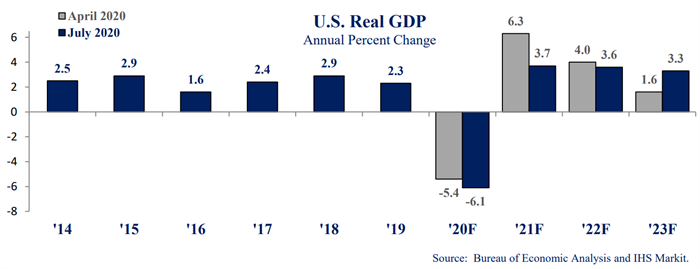We’ve gotten another sobering look at the economic and budget impacts of the coronavirus in the state’s
July Revenue and Economic Update. The quarterly report from Minnesota Management and Budget (MMB) shows that projections for the national economy have gotten even worse. While state revenues have come in a bit ahead of what was predicted in May, the state is still on track for a more than $2 billion budget shortfall for the current budget cycle.
These numbers underscore how the pandemic continues to harm Minnesotans’ health, safety, and economic well-being, and why we need bold action to address those priorities and build a stronger recovery.
Additional federal aid to states, local governments, and tribal governments will be an essential part of that picture – as all these levels of government experience the double whammy of needing to meet the pressing needs of their communities at the same time that their revenues are dropping. State-level policymakers also have a role to ensure Minnesota has the resources it needs for us to take care of each other.
Some of the top takeaways from the Update include:
1.
The economic picture has gotten even worse since April. The economic forecasters now predict a 6.1 percent reduction in the nation’s GDP in 2020, compared to 5.4 percent projected a few months ago. And while the forecasters expect economic growth to resume in 2021, they’ve significantly lowered that projection to only 3.7 percent growth next year.

2.
Revenues to date came in roughly on track compared to the May budget projection. Revenues for FY 2020 came in $168 million - or just 0.8 percent higher than projected earlier. While this is good news, there’s still a huge revenue drop compared to the February Forecast, and the state faces a significant shortfall in this budget cycle.
3.
Unemployment is expected to remain high. In June, the national unemployment rate was 11.1 percent. IHS, the state’s economic forecasters, expect unemployment to remain above 8 percent through the rest of the year, and don’t expect it to return to pre-COVID levels until 2024. This information is slightly better than expected, but the report includes an important caveat – these monthly jobs numbers were collected before the recent spike in COVID cases in several states, so may prove to be too optimistic.
4.
Forecasters note that their projections still “remain highly uncertain.” Since any economic projections are dependent on the severity of the pandemic and efforts to bring it under control, they have high levels of uncertainty. The forecasters assign a 50 percent chance that their baseline economic scenario is correct, and give a 30 percent chance for a more pessimistic scenario that includes an even deeper recession and a slower recovery. They assign a 20 percent probability to a more optimistic scenario in which the impact of COVID is less severe.
These projections include the anticipated impact of the CARES Act and other COVID and economic stimulus measures already taken by Congress. But the update underlines the importance of further federal action. Part of the reason for the worsening economic projections is the drag of state and local government budget cuts, and the update notes that, “Without additional federal support, state and local governments face substantial revenue shortfalls in the coming fiscal years.”
This is a time that will take all the tools in our toolbox so that everyday Minnesotans can weather this health and economic crisis, and to build a stronger and more equitable recovery. Additional federal funding for state and local governments, judicious use of the state’s budget reserve, and fair state revenues are three key tools to get us through.
Federal policymakers are developing their next round of COVID response legislation, and additional aid to state and local governments is an essential piece of ensuring Minnesotans can stay healthy, and keep a roof over their heads and food on the table. Boosting federal aid to the states has a strong economic boost, ensures that key public services can continue, and keeps teachers and other critical public employees on the job. The
Center on Budget and Policy Priorities estimates that states are seeing deeper state budget shortfalls than during the Great Recession, and their calculations don’t even take into account the costs of responding to the pandemic.
The federal government should enact aid to states, tribal governments, and localities as outlined in
the HEROES Act passed by the U.S. House earlier this summer, including both $540 billion in direct grants and a boost to the federal share funding for health care through Medicaid. Under the direct grants portion of this bill, Minnesota could receive about $8 billion over the next two years.
Another tool Minnesota can use to meet the moment’s pressing needs is its strong budget reserve, which has been built up over the past several years to prepare for a time of economic crisis.
Fair state revenues also need to be part of the solution. State revenues are dropping, but the current crisis is not impacting all businesses and people equally. It makes sense to ask those who have not been hard hit – profitable corporations and high-income people – to shoulder more responsibility for funding the essential investments that we need to make to help us all get through.